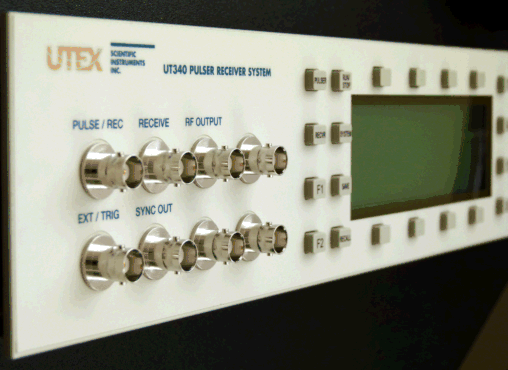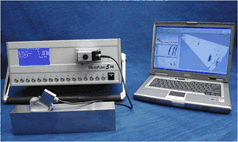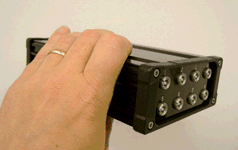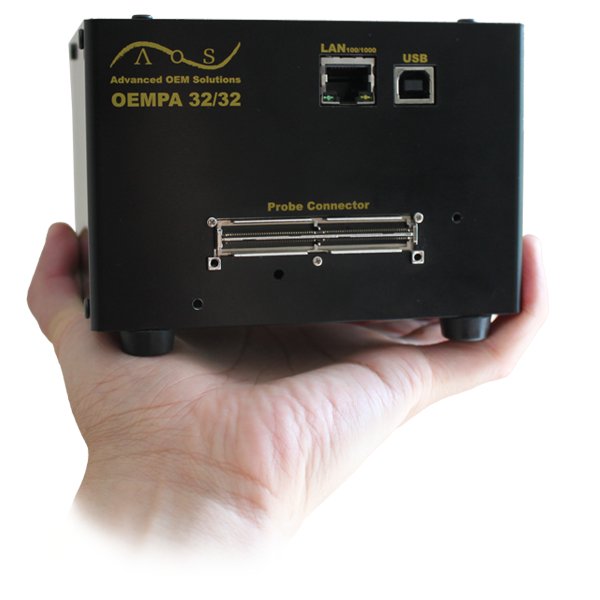|
| Faster, quieter and more channels for higher throughput
These technologies are fully supported on the InspectionWare automation platform.
Wide Dynamic Range instruments reduce scanning time by doing in one scan what would normally require scans at two different gain settings.
High-Frequency ultrasound instruments are useful for finding very small indications and for studying the grain structure and purity of materials.
Ultra-High PRF instruments can scan at insane speeds, thereby pushing out images faster. That's a plus when working at acoustic microscopy frequencies where many scan lines are needed. |  | High Channel Count Instruments reduce scanning time by collecting many channels into one image, thereby cutting the inspection time by the number of transducers used.
Full Matrix Capture, unlike conventional phased array, uses no focal laws for specifying sweep angles and focal depths that might miss out-of-plane indications. Full Matrix Capture renders an image of the full volume of the material under the transducer. Every pixel is in proper focus regardless of the angle or depth from the transducer. There's no need to guess where to aim the sound. |
Instruments that make it possible

Product | 
Description | 
DRE | 
HF | 
HI
PRF | 
NG
PA | 
FMC | 
HCC |


UT 340High Frequency Square Wave Pulser Receiver
| 
This is the world's fastest and only high-speed square wave pulser-receiver. The UT340's exceptionally flat bandwidth and quiet performance has made it an industry standard reference instrument. The low noise floor (-72dB) allows for wide dynamic range data collection when used with a suitable digitizer.
Specifications
Get Product Brochure
Get Product Support | 
■ | 
■ | 
■ | 
| 
| 
|


MicroPulse 5, 5 PA and FMC Conventional/Phased Array and FMC UT Instruments
| 
These very flexible instruments can be used for conventional, phased array and FMC inspections. MicroPulse PA is fully parallel on all channels, whether 64/64, 128/128 or 256/256 elt. Independent voltage control of each element allows for transmit apodization, which can dramatically reduce grating lobes and improve the consistency of sound fields. They define the high-end of phased array inspection.
Specifications - Phased Array
Specifications - Conventional
Download brochure | 
■ | 
| 
| 
■ | 
■ | 
■ |


MicroPulse LTMultichannel UT Instrument with Dynamic Range Expansion
| 
The LT contains eight square wave pulser receivers, yet is only slightly larger than a VHS video cassette. Its small size makes it equally suitable for use in field portable or factory based inspection systems. Power Over Ethernet means that only one cable, the network cable, connects the computer to the instrument. Using DRE, the LT is capable of 96dB of dynamic range, making it perfect for composite inspection without needing a log amp.
Specifications
Download brochure | 
■ | 
| 
| 
| 
| 
■ |


AOS OEMPAUT Phased Array Systems
| 
The AOS OEMPA is available in 16/16, 32/32, 64/64, 32/128, 128/128 and 256/256 channels. Its small size allows it to be located close to the PA transducer in factory systems. It is light enough to be mounted on the arm of a robot or on the mast of a gantry. This mounting flexibility keeps the cable length short and the ultrasonic performance at its maximum. | 
| 
| 
| 
■ | 
■ | 
■ |

| 
| 
| 
| 
| 
| 
| 
|

Dynamic Range Expansion
(DRE) | 
Measurements never need to suffer a loss of information due to signal saturation or quantization. DRE reduces noise corruption to improve dynamic range so that all measurements can be made in the same gain setting. Scan time is cut in half. | 
| 
| 
| 
| 
| 
|

High Frequency Ultrasound
(HF) | 
Typically, any UT above 30MHz is considered high frequency. In the case of the UT340, the range is 1 to 150 MHz. Expect pulse rise times of 2ns or less. | 
| 
| 
| 
| 
| 
|

Ultra-High PRF
(HI PRF) | 
PRF rates over 20 kHz and up to 50 kHz are allowed. It's free of charge and optionally enabled so that transducers are not accidentally damaged. | 
| 
| 
| 
| 
| 
|

Next Generation Phased Array (NGPA) | 
One square wave pulser per channel, pulse voltage control for every element, transmit apodization, DDF integral to the beam former and 16 conventional UT channels make these instruments special. | 
| 
| 
| 
| 
| 
|

Full Matrix Capture
(FMC) | 
FMC is an extension of ultrasonic phased array technology. It offers advantages over traditional phased array because you don't need to decide where to steer or focus in advance. Indications that would have otherwise been missed because of their out of plane orientation are usually imaged correctly.
Many phased array inspections will one day migrate to use Full Matrix Capture instead of using predefined focal laws and sweeps. | 
| 
| 
| 
| 
| 
|

High Channel Count
(HCC) | 
Lots of conventional or phased array channels for reducing inspection times of large surfaces. | 
| 
| 
| 
| 
| 
|
|
 Print
Print Email page
Email page
 Share
Share
 Print
Print Email page
Email page
 Share
Share